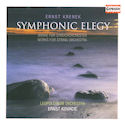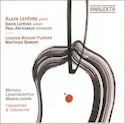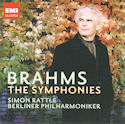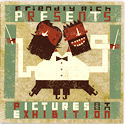 I wonder if it is in the very nature of string orchestra music to be lush. A case in point is the otherwise austere music of Austrian 12-tone composer Ernst Krenek (1900-1991). Ernst Kovacic and the Leopoldinum Orchestra of Wroclaw, Poland have just released Symphonic Elegy – Works for String Orchestra (Capriccio 5033), a collection of Krenek’s compositions from the middle years of his long career. Rather than the angular, atonal fare we might expect from a proponent of serial techniques of composition, to my ear the six works included here are all quite warm and lyrical. The earliest work is also the latest, in the form of a 1960s arrangement of the Adagio and Fugue movements of the sixth string quartet dating from 1936. The quartet was written at a time when Krenek was in close contact with Anton Webern, who he considered to be “one of the most important composers of all times: Music of a crystal clear perfection.” While strongly influenced by Webern, that master’s miniature approach is not in evidence here – with movements lasting about 8 minutes each. Krenek left Austria in 1938 and settled in the USA. It was there that he heard of Webern’s death in 1945 (fatally shot by an American soldier in the final days of the war in a tragic case of mistaken identity) and composed the Symphonic Elegy in his memory. The work is marked Allegro and is more of a celebration than a mournful cry. The disc includes two collections of short movements – Seven Easy/Light Pieces and Five Short Pieces for Strings – which are more akin to Webern’s architecture, if not his pointillist aesthetic. The final work is the Sinfonietta a Brasileira written on a visit to Rio de Janeiro in 1952. I found myself expecting to hear something reminiscent of the flamboyant music of Villa-Lobos, but other than a few moments of rhythmic motor activity which the liner notes tell us actually refer back to an earlier period of Krenek’s development rather than folk influences, there is nothing particularly suggestive of South America in this work. These fine performances present a very thorough picture of one aspect of this prolific and rarely heard composer, but although all of the pieces are worthy of note, at nearly 80 minutes I found a bit too much sameness in the CD when taken all at once.
I wonder if it is in the very nature of string orchestra music to be lush. A case in point is the otherwise austere music of Austrian 12-tone composer Ernst Krenek (1900-1991). Ernst Kovacic and the Leopoldinum Orchestra of Wroclaw, Poland have just released Symphonic Elegy – Works for String Orchestra (Capriccio 5033), a collection of Krenek’s compositions from the middle years of his long career. Rather than the angular, atonal fare we might expect from a proponent of serial techniques of composition, to my ear the six works included here are all quite warm and lyrical. The earliest work is also the latest, in the form of a 1960s arrangement of the Adagio and Fugue movements of the sixth string quartet dating from 1936. The quartet was written at a time when Krenek was in close contact with Anton Webern, who he considered to be “one of the most important composers of all times: Music of a crystal clear perfection.” While strongly influenced by Webern, that master’s miniature approach is not in evidence here – with movements lasting about 8 minutes each. Krenek left Austria in 1938 and settled in the USA. It was there that he heard of Webern’s death in 1945 (fatally shot by an American soldier in the final days of the war in a tragic case of mistaken identity) and composed the Symphonic Elegy in his memory. The work is marked Allegro and is more of a celebration than a mournful cry. The disc includes two collections of short movements – Seven Easy/Light Pieces and Five Short Pieces for Strings – which are more akin to Webern’s architecture, if not his pointillist aesthetic. The final work is the Sinfonietta a Brasileira written on a visit to Rio de Janeiro in 1952. I found myself expecting to hear something reminiscent of the flamboyant music of Villa-Lobos, but other than a few moments of rhythmic motor activity which the liner notes tell us actually refer back to an earlier period of Krenek’s development rather than folk influences, there is nothing particularly suggestive of South America in this work. These fine performances present a very thorough picture of one aspect of this prolific and rarely heard composer, but although all of the pieces are worthy of note, at nearly 80 minutes I found a bit too much sameness in the CD when taken all at once.
 Alain Lefèvre continues to champion the music of André Mathieu with his latest release Concertino & Concertos (Analekta AN 2 9283) which also features music of Shostakovich and Mendelssohn. Mathieu’s concert career began at the age of six and at twelve he premiered his Concertino No. 2 (his Op.13!) with the Orchestre symphonique de Montréal. That work went on to win the New York Philharmonic Competition which led to Mathieu’s 1942 performance of the Concertino at Carnegie Hall. His star continued to rise throughout the 1940s but then waned. He had a tragically short and troubled life (1929-1968) and at the time of his death his creative triumphs were already long behind him. It is the abovementioned Concertino which opens this disc. The stunning virtuosic three movement work shows a maturity that belies the age of its creator. Lefèvre is accompanied by the London Mozart Players led by Matthias Bamert. The recording also includes brilliant performances of Shostakovich’s First Piano Concerto (with Paul Archibald, trumpet) - I had forgotten how the early Shostakovich concerto presages the final work in his orchestral oeuvre, Symphony No. 15 and its extensive use of quotation – and Mendelssohn’s rarely heard Double Concerto with the pianist’s brother David Lefèvre on violin. All in all an exhilarating addition to the catalogue.
Alain Lefèvre continues to champion the music of André Mathieu with his latest release Concertino & Concertos (Analekta AN 2 9283) which also features music of Shostakovich and Mendelssohn. Mathieu’s concert career began at the age of six and at twelve he premiered his Concertino No. 2 (his Op.13!) with the Orchestre symphonique de Montréal. That work went on to win the New York Philharmonic Competition which led to Mathieu’s 1942 performance of the Concertino at Carnegie Hall. His star continued to rise throughout the 1940s but then waned. He had a tragically short and troubled life (1929-1968) and at the time of his death his creative triumphs were already long behind him. It is the abovementioned Concertino which opens this disc. The stunning virtuosic three movement work shows a maturity that belies the age of its creator. Lefèvre is accompanied by the London Mozart Players led by Matthias Bamert. The recording also includes brilliant performances of Shostakovich’s First Piano Concerto (with Paul Archibald, trumpet) - I had forgotten how the early Shostakovich concerto presages the final work in his orchestral oeuvre, Symphony No. 15 and its extensive use of quotation – and Mendelssohn’s rarely heard Double Concerto with the pianist’s brother David Lefèvre on violin. All in all an exhilarating addition to the catalogue.
 EMI has just released Brahms – The Symphonies, a 3CD set with Simon Rattle and the Berliner Philharmoniker (2 67254 2). Brahms’ Symphony No. 1, or as it is affectionately known, “Beethoven’s 10th”, is one of the pillars of the symphonic repertoire for me and I must confess that repeated listening to it is as far as I have got with this new cycle. While it will likely not replace my “desert island” pick of Carlo Maria Giulini conducting the Los Angeles Philharmonic on an old DG digitally recorded LP – I do hope there will be a turntable on that fabled isle - I find Sir Simon’s majestic performance well balanced and well paced. The sound of the orchestra is glorious, captured in its natural habitat of the Philharmonie last October and November. My resolution? One of these days to start at disc two of this set so that I may get past the fabulous first and explore the other three symphonies on offer here.
EMI has just released Brahms – The Symphonies, a 3CD set with Simon Rattle and the Berliner Philharmoniker (2 67254 2). Brahms’ Symphony No. 1, or as it is affectionately known, “Beethoven’s 10th”, is one of the pillars of the symphonic repertoire for me and I must confess that repeated listening to it is as far as I have got with this new cycle. While it will likely not replace my “desert island” pick of Carlo Maria Giulini conducting the Los Angeles Philharmonic on an old DG digitally recorded LP – I do hope there will be a turntable on that fabled isle - I find Sir Simon’s majestic performance well balanced and well paced. The sound of the orchestra is glorious, captured in its natural habitat of the Philharmonie last October and November. My resolution? One of these days to start at disc two of this set so that I may get past the fabulous first and explore the other three symphonies on offer here.
 Orchestration is a fine art and a piano piece which has tempted the hand of a number of masterful orchestrators since its creation in 1874 is Mussorgsky’s Pictures at an Exhibition. Wikipedia lists some 30 arrangements for orchestra and more than 80 for other forces thus far, and Ontario composer Richard Marsella – AKA Friendly Rich – has just thrown his hat into the ring (Pumpkin Pie Corporation PPCD006). Although I have obviously not heard all of the others, I can’t help thinking that this Looney Tunes-like arrangement for the forces of the Lollipop People (percussion; trombone & euphonium; synthesizer; kazoo; toy piano, piano & harpsichord; bassoon & penny whistle; clarinets; accordion; harp; electric guitar; drums and electric bass) must be among the most unusual. Particularly effective for me is the extensive use of bassoon (Jeffrey Burke), especially in combination with harpsichord (Gregory Oh) and accordion (Kimberley Pritchard). Friendly Rich certainly has an ear for remarkable tone colours and the instrumentation changes substantially from movement to movement. Perhaps the wackiest is the Cum mortuis in lingua mortu with vocalizations by guests Paul Dutton and Christine Duncan. I must confess however that I find the coarse surprise ending of the otherwise effective finale, The Great Gate of Kiev, disconcerting and a little disappointing. Concert Note: You can experience the full force of Friendly Rich’s bizarre interpretation of Pictures at an Exhibition for yourself at the CD launch at the Tranzac Club on Saturday November 7th.
Orchestration is a fine art and a piano piece which has tempted the hand of a number of masterful orchestrators since its creation in 1874 is Mussorgsky’s Pictures at an Exhibition. Wikipedia lists some 30 arrangements for orchestra and more than 80 for other forces thus far, and Ontario composer Richard Marsella – AKA Friendly Rich – has just thrown his hat into the ring (Pumpkin Pie Corporation PPCD006). Although I have obviously not heard all of the others, I can’t help thinking that this Looney Tunes-like arrangement for the forces of the Lollipop People (percussion; trombone & euphonium; synthesizer; kazoo; toy piano, piano & harpsichord; bassoon & penny whistle; clarinets; accordion; harp; electric guitar; drums and electric bass) must be among the most unusual. Particularly effective for me is the extensive use of bassoon (Jeffrey Burke), especially in combination with harpsichord (Gregory Oh) and accordion (Kimberley Pritchard). Friendly Rich certainly has an ear for remarkable tone colours and the instrumentation changes substantially from movement to movement. Perhaps the wackiest is the Cum mortuis in lingua mortu with vocalizations by guests Paul Dutton and Christine Duncan. I must confess however that I find the coarse surprise ending of the otherwise effective finale, The Great Gate of Kiev, disconcerting and a little disappointing. Concert Note: You can experience the full force of Friendly Rich’s bizarre interpretation of Pictures at an Exhibition for yourself at the CD launch at the Tranzac Club on Saturday November 7th.
We welcome your feedback and invite submissions. CDs and comments should be sent to: The WholeNote, 503 – 720 Bathurst St. Toronto ON M5S 2R4. We also encourage you to visit our website, , where you can find added features including weekly CD giveaways, direct links to performers, composers and record labels, “buy buttons” for on-line shopping and additional and archival reviews.
David Olds
DISCoveries Editor
discoveries@thewholenote.com



